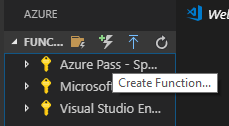This is a http trigger function written in C# - .NET Core 3.1. It processed a csv file and store the data on Cosmos DB
GitHub repo : https://github.com/hansamaligamage/fncsvdatastore
public static async Task<CloudTable> CreateTableAsync(string tableName)
{
CloudTable table;
string storageConnectionString = LoadConnectionDetails();
CloudStorageAccount storageAccount = RetieveStorageAccount(storageConnectionString);
CloudTableClient tableClient = storageAccount.CreateCloudTableClient(new TableClientConfiguration());
Console.WriteLine("Table client is created");
try
{
table = tableClient.GetTableReference(tableName);
if (await table.CreateIfNotExistsAsync())
{
Console.WriteLine("Table is created - {0}", tableName);
}
else
{
Console.WriteLine("Table {0} already exists", tableName);
}
}
catch (Exception ex)
{
throw ex;
}
Console.WriteLine();
return table;
}
GitHub repo : https://github.com/hansamaligamage/fncsvdatastore
Technology stack
- .NET Core 3.1 on Visual Studio 2019
- Azure functions v3 and Azure Cosmos DB table API
Some code snippets
Retrieve the database storage account
public static CloudStorageAccount RetieveStorageAccount(string storageConnectionString) { CloudStorageAccount storageAccount; try { storageAccount = CloudStorageAccount.Parse(storageConnectionString); } catch (FormatException) { Console.WriteLine("Invalid storage account information provided"); throw; } catch (ArgumentException) { Console.WriteLine("Please check the storage account details"); Console.ReadLine(); throw; } catch(Exception ex) { throw ex; } return storageAccount; }Create a table in Cosmos DB
public static string LoadConnectionDetails() { return Environment.GetEnvironmentVariable("StorageConnectionString"); }
public static async Task<CloudTable> CreateTableAsync(string tableName)
{
CloudTable table;
string storageConnectionString = LoadConnectionDetails();
CloudStorageAccount storageAccount = RetieveStorageAccount(storageConnectionString);
CloudTableClient tableClient = storageAccount.CreateCloudTableClient(new TableClientConfiguration());
Console.WriteLine("Table client is created");
try
{
table = tableClient.GetTableReference(tableName);
if (await table.CreateIfNotExistsAsync())
{
Console.WriteLine("Table is created - {0}", tableName);
}
else
{
Console.WriteLine("Table {0} already exists", tableName);
}
}
catch (Exception ex)
{
throw ex;
}
Console.WriteLine();
return table;
}
Create a row in the Cosmos DB
public static async Task InsertOrUpdateEntityAsync(CloudTable table, Session session) { if (session == null) { throw new ArgumentNullException("Session is empty"); } try { TableOperation tableOperation = TableOperation.InsertOrMerge(session); TableResult result = await table.ExecuteAsync(tableOperation); Session newSession = result.Result as Session; if (result.RequestCharge.HasValue) { Console.WriteLine("Request Charge of the operation: " + result.RequestCharge); } return newSession; } catch (StorageException e) { Console.WriteLine(e.Message); Console.ReadLine(); throw; } catch (Exception ex) { throw ex; } } Read a row in the Cosmos DB
public static async Task RetrieveEntityAsync(CloudTable table, string partitionKey, string rowKey) { try { TableOperation tableOperation = TableOperation.Retrieve(partitionKey, rowKey); TableResult result = await table.ExecuteAsync(tableOperation); Session session = result.Result as Session; if (session != null) { Console.WriteLine("\t{0}\t{1}\t{2}\t{3}", session.PartitionKey, session.RowKey, session.Points, session.IsWeekend); } if (result.RequestCharge.HasValue) { Console.WriteLine("Request Charge of Retrieve Operation: " + result.RequestCharge); } return session; } catch (StorageException e) { Console.WriteLine(e.Message); Console.ReadLine(); throw; } catch (Exception ex) { throw ex; } } 



































